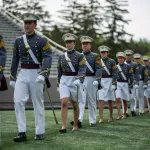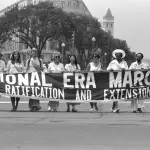Editor’s note: This article was updated in June 2025.
As the law currently stands, every “male citizen” and immigrant — regardless of legal status — between the ages of 18 and 26 must register with the Selective Service System, the agency responsible for running a draft. But the military has not issued a draft since 1973, instead relying on an all-volunteer force.
Kathy Roth-Douquet, the chief executive of Blue Star Families, a nonprofit founded in 2009 by military spouses, said there is still a possibility that the country needs to use a draft again. About 83 percent of military families are anticipating a major conflict in the coming years, according to the latest Blue Star Families annual survey, the largest and most comprehensive of its kind, which included input from more than 100,000 people in the military community.
“Our force is designed to have a draft if we have a mass mobilization,” Roth-Douquet told The 19th in April. “I think a lot of people think that because the all-volunteer force has been so extraordinarily successful for 50 years, that’s all we’re ever going to have. But the actual war plans that we have to fight a major conflict require mass mobilization — which is the draft.”
When President Donald Trump took office for his second term, several regions around the world were experiencing tension and active conflict that could potentially impact Americans — including the Israeli-Palestinian conflict, the Russia-Ukraine war; and the trade war with China initiated during Trump’s first term. Tensions in some of those conflict zones, particularly in the Middle East, have flared since then.
“No one really wants to talk about this — it almost feels like an impolite thing,” Roth-Douquet said. “I often find that no one wants to go there, but the fact of the matter is there isn’t really an alternative. The state actors who would be involved would be mobilizing at a pace where we don’t have time to go through the volunteer acceptance process, just from a practical perspective.”
And if the country reinstates the draft, there is a real chance women would be added to the law’s language this time. If drafted, it is likely that women would fill non-combat supporting roles, including those in intelligence, communications, science, engineering or health care.
About 45 years ago, the Supreme Court upheld the constitutionality of requiring only men to register for the draft because women were not allowed in combat roles. But the Department of Defense formally lifted the ban on women in combat a decade ago, so the reasoning for keeping women out of the draft — one of the last sex-based classifications in federal law — is less clear. In 2021, the Supreme Court declined to address the issue, deferring to Congress.
Justice Sonia Sotomayor wrote in that 2021 decision: “It remains to be seen, of course, whether Congress will end gender-based registration under the Military Selective Service Act. But at least for now, the court’s longstanding deference to Congress on matters of national defense and military affairs cautions against granting review while Congress actively weighs the issue.”
Opening up the selective service to all genders has bipartisan support in Congress, but some of the loudest opposition stems from conservatives who have said America’s “daughters, sisters and wives” should not be compelled to “fight our wars.”
Have questions about the military or the draft and gender? Email us.
What would it look like if women were added to the draft?
Everyone, including women, would be required to register with Selective Services when they turned 18. However, registration does not equal mandatory conscription. Involuntary summons have been used only a handful of times, most recently during the Vietnam War.
Kara Dixon Vuic, who studies gender and the U.S. military at Texas Christian University, said the passage of this amendment would be “huge, though largely symbolic” when it comes to the fight for women’s rights and gender equity in the military.
“Right now, the only legal difference between what men and women do as civilians is men sign up for selective service,” said Vuic, who has written about the history of military draft eligibility in the country. “It’s not that women don’t have to; it’s that they can’t.”
In 1980, when the Carter administration sought to reactivate the draft, a group of men filed a lawsuit arguing that the law violated the Fifth Amendment and supported gender-based discrimination. The following year, the Supreme Court ruled that because women were banned from combat roles, they could also be excluded from conscription.
The ban on women serving in combat roles was lifted in 2013. Since then, Vuic said the change in conscription policy has been expected.
How likely is it that the draft will be reinstated?
The United States has maintained an all-volunteer military for nearly 50 years and recently concluded its longest-fought war without turning to the draft.
“We fight wars differently now,” Vuic said. “Most people who think about this kind of issue don’t think there will be a draft again. The kind of massive land armies and total-war invasions seem to have gone by the wayside. Our technology, weapons and goals are different.”
Historically, the draft has impacted single men from lower middle classes — those with fewer options. Those who were married, responsible for dependents or enrolled in college courses were eligible for exemptions. In an effort to ensure a more fair and equitable system, the Nixon administration ordered a lottery system in the late 1960s.
If Congress and the president were to suddenly reinstate a military draft today, the Selective Service System would conduct a lottery to determine who is drafted — prioritizing the 20-25 age group, according to the agency.
Even if a woman were to be randomly chosen to serve, Vuic said, they are still probably not going to be sent into active combat. Most men who were drafted in World War II, she added, were not sent to the front line as there was a higher need to fill roles in intelligence, science, engineering, health care and aviation.

What is the history of conscription in the United States?
There have been different iterations of mandatory military service throughout U.S. history, but drafts are fairly rare and have always been controversial, Vuic said. Many believe that conscription is an overreach or abuse of federal power on civilians’ freedoms.
Under British rule, each colony formed its own militia composed of adult men. During the Revolutionary War, George Washington struggled to attract enough soldiers with cash and the promise of land. After the war, as the country’s first commander-in-chief, Washington tried and failed to pass legislation to register all men for military service.
It wasn’t until the Civil War in the 1860s when Congress gave President Abraham Lincoln authority to require the registration of all able-bodied men between the ages of 20 and 45. The Confederacy also passed its own conscription law, requiring all White men — and later slaves — between 17 and 50 to serve for three years.
Congress authorized drafts again during the Spanish-American War in 1898 and in both world wars. During World War I, the Selective Service Act in 1917 drew a wave of opposition. Tens of thousands of men applied for exemptions, hundreds of thousands failed to register altogether and more than 75,000 were arrested in New York. There was less opposition in 1940, as the United States warily watched World War II unfold. Following the attack on Pearl Harbor in 1941, the lawmakers gave the president power to send draftees all over the world. Then again in 1948 as the Cold War intensified, President Harry Truman reinstated the draft for men between 19 and 26.
In 1965, opposition to the war in Vietnam and protests against the draft spread on college campuses and military centers. In the following years, thousands of young men destroyed their draft cards or left the country. The Selective Service Act expired in 1973 and ended the government’s ability to enforce conscription.
In 1980, the Selective Service System became active again, but the United States continues to operate an all-volunteer policy. There have been repeated efforts in Congress to include women, including in 2014 and 2015. Then, in 2017 the Senate passed the annual defense authorization act but the requirement to include women was later removed while the National Commission on Military National and Public Service studied the issue. The commission released its final report in 2020 and recommended requiring women to register for selective service.
Including women in the draft has bipartisan support. What are the proponents saying?
Many experts and women veterans applaud a move toward equity in the military.
Suzanne Chod, a professor of political science at North Central College in Illinois, said there is not strong public support for women registering for the draft. Though a bipartisan issue, support still tends to fall along party lines, with Democrats more likely to identify as feminists who support complete gender equity, she added.
“This overall lack of strong support, though, illustrates what we call benevolent sexism, which is a sexism that rests on paternalistic beliefs: ‘Women need protection, and their skills are nurturers, not fighters. We need to protect them from war so as to not corrupt their virtue and purity and inhibit them from fulfilling their duties as wives and mothers,’” Chod said. “This was the same argument made in the 19th and early-20th centuries to bar women from voting.”
Jen Burch, a 34-year-old Air Force veteran who deployed to Afghanistan in 2010, said she supports the change, alongside most women in the military. Women are the fastest-growing veteran population, and more than 300,000 women served in Afghanistan and Iraq.
“This is another step in moving forward for women to be equal, to have the same responsibilities,” Burch said. “Women are just as good as men and should be part of the draft.”
During his time as a Republican congressman representing Florida, Mike Waltz, a former Army Green Beret, voiced support for including women in the draft. (Waltz has since served as Trump’s national security advisor and ambassador to the United Nations.) Sen. Kirsten Gillibrand of New York, a Democrat, and Sen. Joni Ernst of Iowa, a Republican and the first woman combat veteran elected to the Senate, have also publicly supported the change.
What about those who oppose this change?
According to a 2021 Ipsos poll, overall public support for drafting women has decreased in recent years. In 2016, 63 percent of Americans supported drafting women in the event that Congress reinstated conscription. In 2021, that number was 45 percent — with more than half of all men and about a third of all women in favor.
In addition, about a dozen Republicans — including Sen. Josh Hawley of Missouri, Sens. Ted Cruz of Texas, Tom Cotton and John Boozman of Arkansas, Cindy Hyde-Smith of Mississippi and Mike Lee of Utah — have opposed attempts to change conscription policy to include women.
“It’s one thing to allow American women to choose this service, but it’s quite another to force it upon our daughters, sisters and wives,” Hawley tweeted in 2021. “Missourians feel strongly that compelling women to fight our wars is wrong and so do I.”
Cotton also posted on social media in 2021, saying the military has “welcomed women for decades and are stronger for it. But America’s daughters shouldn’t be drafted against their will.”
If women were added to the draft, the United States would move closer to standards held by other countries, Vuic said. In Norway and Sweden, military or some form of national service is required of everyone. In Israel and North Korea, women are expected to serve but with caveats, including ones that explicitly bar combat roles.
“The military relies on women in service,” Vuic said. “Those opposed to women being conscripted are not saying no women in the service altogether — but just conscriptive service, particularly conscriptive combat. That argument conflates a socially and culturally conservative idea that, to me, says they don’t fundamentally see men and women as equals.”







